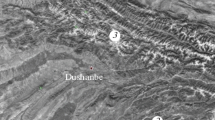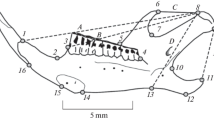Abstract
The structure of Thymus petraeus individuals has been studied architecturally. It has been established that in the south of Siberia the species occurs in similar habitats: in true, meadow, sandy steppes and their petrophytic variants on the slopes and low rocky peaks of hills. According to the classification proposed by I.G. Serebryakov (1964), T. petraeus is a vegetatively semimobile dwarf shrub with a system of the main root that is persistent throughout its life and with rooting runners. Three architectural units that differ in the spatial position of the compound skeletal axis (orthotropic–plagiotropic, plagiotropic, and orthotropic) have been identified in the structure of T. petraeus individuals. Each architectural unit consists of the main compound skeletal axis, compound skeletal axes of the 1st order, formation shoots, branching shoots, and enrichment shoots. It is shown that the structure of individuals can be formed by repeating only two architectural units. It is established that the structure of individuals growing in the true steppes and their petrophytic variants is built at the expense of the repetition of orthotropic–plagiotropic and plagiotropic architectural units. That in sandy steppes is built at the expense of repetition of plagiotropic and orthotropic architectural units. The features of T. petraeus development in specific ecological and coenotic conditions are shown. In this regard, we have characterized (1) morphological polyvariance, which is based on changes in the structure of shoots (shortened and elongated) and the composition of architectural units (no compound skeletal axes of the 1st order or enrichment shoots); (2) dimensional polyvariance, manifested in a change in the length and number of compound skeletal axes; and (3) dynamic polyvariance, associated with fluctuations in the duration of the monopodial growth of shoots formation (from 2 to 5 years) and the architectural unit as a whole (from 6 to 20 years). The revealed modifications of architecture do not lead to a change in the life form of the dwarf shrub, but reflect the mechanisms of its adaptation.






Similar content being viewed by others

REFERENCES
Antonova, I.S. and Gnilovskaya, A.A., Shoot system of Acer negundo L. (Acereceae) in different age, Bot. Zh., 2013, no. 98 (1), pp. 53–68.
Astashenkov, A.Yu. and Cheryomushkina, V.A., Architectural model Nepeta mariae (Lamiaceae), Rastit. Mir Aziat. Ross., 2016, no. 4, pp. 22–29.
Barthélémy, D. and Caraglio, Y., Plant architecture: a dynamic, multilevel and comprehensive approach to plant form, structure and ontogeny, Ann. Bot., 2007, vol. 99, no. 3, pp. 375–407.
Barthélémy, D., Edelin, C., and Hallé, F., Architectural concepts for tropical trees, in Tropical Forests: Botanical Dynamics, Speciation and Diversity, Holm-Nielsen, L.B. and Balslev, H., Eds., London: Academic, 1989, pp. 89–100.
Charles-Dominique, T., Edelin, C., and Bouchard, A., Architectural strategies of Cornus sericea, a native but invasive shrub of Southern Quebec, Canada, under an open or a closed canopy, Ann. Bot., 2010, vol. 105, no. 2, pp. 205–220.
Cheryomushkina, V.A. and Guseva, A.A., Life form of Scutellaria supine L. (Lamiaceae), Contemp. Probl. Ecol., 2015, vol. 8, no. 5, pp. 756–769.
Cheryomushkina, V.A. and Talovskaya, E.B., Life forms of some Thymus (Lamiaceae) species: an architectural approach, Bot. Zh., 2019, vol. 104, no. 3, pp. 44–57.
Dorogostoiskaya, E.V., Conspect of flora of flowering plants in Ilmen Nature Reserve, in Flora i rastitel’nost’ Il’menskogo gosudarstvennogo zapovednika im. V.I. Lenina (Flora and Vegetation of the Lenin Ilmen State Nature Reserve), Tr. Il’menskogo Gos. Zapov. im. V.I. Lenina no. 8, Sverdlovsk, 1961, pp. 9–50.
Doron’kin, V.M., 27. Thymus L., in Flora Sibiri. Tom 1. Pyrolaceae–Lamiaceae (Labiatae) (Flora of Siberia, Vol. 1: Pyrolaceae–Lamiaceae (Labiatae)), Malyshev, L.I., Ed., Novosibirsk: Nauka, 1997, pp. 205–220.
Edelin, C., The Monopodial Architecture: The Case of Some Tree Species from Tropical Asia, Research pamphlet no. 105, Kuala Lumpur: Forest Res. Inst. Malaysia, 1990, pp. 1–222.
Ermakov, N.B., Polyakova, M.A., and Smorgov, A.E., Associations of petrophytic steppe communities from Altai-Sayan mountain area. 1. Communities of Selaginella sanguinokenta in Western Sayan and Tuva, Vestn. Novosib. Gos. Univ., Ser.: Biol.,Klin. Med., 2009, vol. 7, no. 4, pp. 37–44.
Flora of China, Vol. 17: Verbenaceae through Solanaceae, St. Louis: Missouri Bot. Garden, 1994.
Gamayunova, A.P. and Dmitrieva, A.A., Thymus L., in Flora Kazakhstana (Flora of Kazakhstan), Pavlov, N.V., Ed., Alma-Ata: Akad. Nauk KazakhSSR, 1964, vol. 7, pp. 445–461.
Gambino, S., Ratto, F., and Bartoli, A., Architecture of the genus Gutierrezia (Asteraceae: Astereae, Solidagininae), Bol. Soc. Argent. Bot., 2016, vol. 51, no. 4, pp. 657–663.
Gogina, E.E., Izmenchivost’ i formoobrazovanie v rode tim’yan (Variability and Formation in Genus Thymus L.), Moscow: Nauka, 1990.
Gorchakovskii, P.L. and Zolotareva, N.V., Phytodiversity of relict steppe enclaves in the Urals: experience in comparative assessment, Russ. J. Ecol., 2006, vol. 37, no. 6, pp. 378–386.
Götmark, F., Götmark, E., and Jensen, A.M., Why be a shrub? A basic model and hypotheses for the adaptive values of a common growth form, Front. Plant Sci., 2016. https://doi.org/10.3389/fpls.2016.01095
Hallé, F. and Oldeman, R.A.A., Essai Sur L’architecture et la Dynamique de Croissance Des Arbres Tropicaux, Paris: Masson, 1970.
Kolegova, E.B. and Cheryomushkina, V.A., Ontogenesis of Thymus petraeus Serg. in steppe regions of Khakassia Republic, Rastit. Resur., 2009, vol. 45, no. 3, pp. 1–8.
Kolegova, E.B. and Cheryomushkina, V.A., Ontogenetic structure of cenopopulations of Thymus petraeus (Lamiaceae) in steppe plant communities of Khakassia, Rastit. Resur., 2011, vol. 47, no. 1, pp. 16–24.
Koroleva, A.S., The list of flora of Khakassia, in Rastitel’nyi pokrov Khakasii (Vegetation Cover of Khakassia), Kuminova, A.V., Ed., Novosibirsk: Nauka, 1976, pp. 377–416.
Kostina, M.V., Barabanshikova, N.S., Bityugova, G.V., Yasinskaya, O.I., and Dubach, A.M., Structural modifications of birch (Betula pendula Roth.) crown in relation to environmental conditions, Contemp. Probl. Ecol., 2015, vol. 8, no. 5, pp. 584–597.
Kuminova, A.V., Zvereva, G.A., and Lamanova, T.G., Steppes, in Rastitel’nyi pokrov Khakasii (Vegetation Cover of Khakassia), Kuminova, A.V., Ed., Novosibirsk: Nauka, 1976, pp. 95–152.
Mazurenko, M.T. and Khokhryakov, A.P., Struktura i morfogenez kustarnikov (The Structure and Morphogenesis of Scrubs), Moscow: Nauka, 1977.
Myadelets, M.A., Domracheev, D.V., and Vodolazova, S.V., Analysis of chemical composition of essential oils of Nepeta sibirica L., Thymus petraeus Serg., and Schizonepeta multifida L. growing in Khakassia Republic, Khi-m. Rastit. Syr’ya, 2012, no. 4, pp. 119–124.
Millan, M., Rowe, N.P., and Edelin, C., Deciphering the growth form variation of the Mediterranean chamaephyte Thymus vulgaris L. using architectural traits and their relations with different habitats, Flora, 2019, vol. 251, pp. 1–10.
Navarro, T., Pascual, V., Cabezudo, B., and Alados, C., Architecture and functional traits of semi-arid shrub species in Cabo de Gata Natural Park, SE Spain, Candollea, 2009, vol. 64, pp. 69–84.
Nedoseko, O.I. and Viktorov, V.P., Architecture model of Salix traindra L. and Salix fragilis L., Sots.-Ekol. Tekhnol., 2016, no. 2, pp. 39–50.
Notov, A. and Kusnetzova, T., Architectural units, axiality and their taxonomic implications in Alchemillinae, Wulfenia, 2004, vol. 11, pp. 85–130.
Pashkova, G.A., Florogeneticheskii analiz stepnoi flory gor Yuzhnoi Sibiri (Florogenetic Analysis of Steppe Flora of Mountains of Southern Siberia), Novosibirsk: Nauka, 2001.
Sabatier, S. and Barthélémy, D., Growth dynamics and morphology of annual shoots according to their architectural position in young Cedrus atlantica (Endl.) Manetti ex Carrière (Pinaceae), Ann. Bot., 1999, vol. 84, no. 2, pp. 387–392.
Serebryakov, I.G., Life forms of higher plants and their analysis, Polevaya Geobot., 1964, vol. 3, pp. 146–208.
Stepanov, N.V., Sosudistye rasteniya Prieniseiskikh Sayan (Vascular Plants of Yenisei River Sayan Mountains), Krasnoyarsk: Sib. Fed. Univ., 2016.
Talovskaya (Kolegova), E.B., Thymus baicalensis (Lamiaceae) morphological transformation under different environmental conditions, Contemp. Probl. Ecol., 2015, vol. 8, no. 5, pp. 736–749.
Talovskaya, E.B., Polyvariance of Thymus mugodzharicus (Lamiaceae) ontogeny of the cushion-like life form, Vestn. Tomsk. Gos. Univ., Biol., 2017, no. 40, pp. 88–101.
Tumidajowicz, D., Architecture of the growth and development of the two alpine rhododendron species Rhododendron hirsutum and Rhododendron ferrugineum as a basis for the verification of the assessed relative and absolute age of aboveground shoots, Oecologia, 2005, vol. 14, pp. 1–10.
Funding
This work was supported by the Russian Foundation for Basic Research as part of scientific project no. 18-04-00621 and within the framework of the state assignment of the Central Siberian Botanical Garden, Siberian Branch, Russian Academy of Sciences, project no. AAAA-A17-117012610053-9.
Author information
Authors and Affiliations
Corresponding author
Ethics declarations
COMPLIANCE WITH ETHICAL STANDARDS
The study was performed without the use of animals and without involving people as subjects.
CONFLICT OF INTERESTS
Conflict of interests. The authors declare that they have no conflicts of interest.
Statement on the welfare of animals. This article does not contain any studies involving animals performed by any of the authors.
Additional information
Translated by M. Shulskaya
Rights and permissions
About this article
Cite this article
Talovskaya, E.B., Cheryomushkina, V.A. & Barsukova, I.N. Architecture of the Dwarf Shrub Thymus petraeus (Lamiaceae) in the Conditions of Southern Siberia. Contemp. Probl. Ecol. 13, 85–94 (2020). https://doi.org/10.1134/S1995425520010102
Received:
Revised:
Accepted:
Published:
Issue Date:
DOI: https://doi.org/10.1134/S1995425520010102



